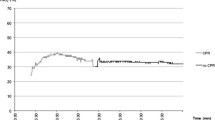Abstract
Adrenaline is an important pharmacologic treatment during cardiac arrest (CA) for resuscitation. Recent studies suggest that adrenaline increases the likelihood of return of spontaneous circulation (ROSC) but does not contribute to improving neurological outcomes of CA. The mechanisms have not been elucidated yet. A bimodal increase in mean arterial pressure (MAP) is observed after adrenaline injection in rodent CA models (Okuma et al. Intensive Care Med Exp 7(1), 2019). In this study, we focused on alteration of systemic arterial pressure in conjunction with the measurement of cerebral blood oxygenation (CBO) such as oxyhemoglobin (Oxy-Hb), deoxyhemoglobin (Deoxy-Hb), and tissue oxygenation index (TOI) by near-infrared spectroscopy (NIRS). Male Sprague-Dawley rats were used. We attached NIRS between the nasion and the upper cervical spine. Rats underwent 10 minute asphyxia to induce CA. Then, cardiopulmonary resuscitation (CPR) was started, followed by a 20 μg/kg of bolus adrenaline injection at 30 seconds of CPR. This injection accelerated the first increase in MAP, and ROSC was observed with an abrupt increase in CBO. Interestingly, the second increase in MAP, once it exceeded a certain value, was accompanied by paradoxical decreases of Oxy-Hb and TOI while Deoxy-Hb increased. Based on this finding, we compared Oxy-Hb, Deoxy-Hb, and TOI at the first MAP ≈ 100 mmHg and the second MAP ≈ 100 mmHg. The average of Oxy-Hb and TOI from the 13 animals significantly decreased at the second increase in MAP over 100 mmHg while Deoxy-Hb significantly increased. NIRS identified a decrease in Oxy-Hb after ROSC. These findings may be a clue in understanding the mechanism of how and why adrenaline alters the neurological outcomes of CA post resuscitation.
Access this chapter
Tax calculation will be finalised at checkout
Purchases are for personal use only
Similar content being viewed by others
Change history
03 December 2021
The Publisher has retracted this chapter (Chapter 44, pp 277-281) as it was included in the “Tumor Oxygenation and Modeling” section of this book in error duplicating Chapter 6 (pp. 39-43) in the “Oxygen Metabolism and Health Monitoring” section. The Publisher apologises to the authors, the Editors and readers for this error. All authors agree with this retraction
Author information
Authors and Affiliations
Editor information
Editors and Affiliations
Rights and permissions
Copyright information
© 2021 Springer Nature Switzerland AG
About this chapter
Cite this chapter
Okuma, Y. et al. (2021). RETRACTED CHAPTER: Effect of Adrenaline on Cerebral Blood Oxygenation Measured by NIRS in a Rat Asphyxia Cardiac Arrest Model. In: Nemoto, E.M., Harrison, E.M., Pias, S.C., Bragin, D.E., Harrison, D.K., LaManna, J.C. (eds) Oxygen Transport to Tissue XLII. Advances in Experimental Medicine and Biology, vol 1269. Springer, Cham. https://doi.org/10.1007/978-3-030-48238-1_44
Download citation
DOI: https://doi.org/10.1007/978-3-030-48238-1_44
Published:
Publisher Name: Springer, Cham
Print ISBN: 978-3-030-48236-7
Online ISBN: 978-3-030-48238-1
eBook Packages: Biomedical and Life SciencesBiomedical and Life Sciences (R0)




